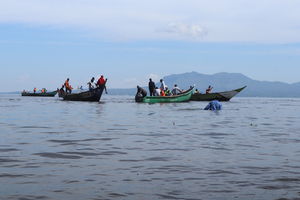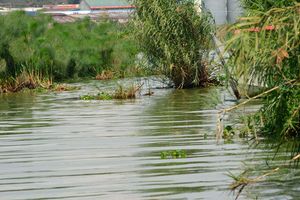
Fish farmers at Mulukoba Beach in Port Victoria making use of boats to gather tons of dead fish from their fish cages on September 29, 2024.
At Mulukoba Beach in Busia County, 71-year-old Albert Hunga Aboli watches pensively as the boat carrying another batch of dead fish from one of his cages in Lake Victoria approaches the shore.
It is the fifth time the vessel is docking at the beach with dead fish scooped from some of his cages in the lake.
"I have suffered a huge loss," is all he could say while appearing to fight back tears.
Mr Hunga's predicament is shared by Adam Gina, who puts his losses in the range of Sh5 million.
"We are estimating the total loss to be 50 tonnes. Now, if you calculate that with Sh350 per kilogramme, you will be able to get a clear picture of what we have lost as a community," said Mr Gina.
The farmers said that nearly all the fish in the 300 cages were found floating on the water with several of them gasping for breath.
Inside one of the cold rooms at Mulukoba fish landing site, a facility that was commissioned by President William Ruto one year ago, workers were in a rush to stock some of the salvaged fish on the shelves even as the farmers blamed the government for failing to equip the facility well.

Fish farmers are counting losses after tons of fish die in cages at Mulukoba Beach in Port Victoria on September 29, 2024.
"How I wish that this facility was operating to full capacity. We could have stored some of the salvaged fish inside there and avoided this devastating loss," lamented Mr Gina.
Some farmers disclosed that they sensed that something was amiss on Friday after they spotted fish through CCTV cameras floating in the cages.
"I quickly dispatched some of my workers to go and investigate and they found several fish dead in the cages," said Mr Ibrahim Okello.
Mr Okello further said that they noted a worrying change in the colour of the lake water in the middle of September before the mass fish deaths started.
"We alerted officials at the Kenya Marine and Fisheries Research Institute who came and collected some samples for analysis but three days later they informed us that the water was safe. So we don't know what is happening?" he posed.
While ruling out poisoning as a possible cause of the deaths, Joachim Omollo, who has been in the fish farming business since 2018, suspected that the aquatic animal could be dying due to insufficient oxygen.
"After KMFRI had ruled out water we thought maybe it is a lack of oxygen, but that is just a speculation, we are not experts," said Mr Omollo.
His suspicions however seemed to be in harmony with those of the KMFRI officers, who visited the area on Sunday evening to conduct investigations.
"Water is very fluid so you find that when the cold water at the bottom of the lake with zero oxygen, due to increased decomposition, replaces the warm surface water as a result of currents, it kills the fish, more so the caged ones since they are stationary," explained Dr Christopher Mulanda Aura, the director in charge of Freshwater Systems Research at KMFRI.
Dr Mulanda further disclosed that their investigations had observed that spacing between cages was not properly done.
"Lumping 160 cages in the same area increases the chances of fish mortalities due to deterioration of water quality. There should be a buffer of about 10 metres from one assembly of cages to another to minimise losses,' he warned.
He advised the farmers to be vigilant, especially during September–November, and May-July; and take notice of any changes in lake water such as foam, milkish development, and change in water turbidity (dirtiness) and harvest or transfer fish to minimise losses.
Documented and existing KMFRI studies dating back to the historical fish kills have shown that Lake Victoria water experiences annual cycles of low oxygenated waters in September–November, and May-July.
In 2022 and 2023, cage fish farmers in Rudacho Beach in Busia County lost tonnes of fish worth millions of shillings due to upwelling.
During the same period, farmers in Kisumu County recorded a massive loss following the deaths of fish in Lake Victoria.
Experts linked the incident to pollution of the lake and climate change. Most of the farmers had expected to harvest the aquatic animals during that period but that was not the case.









